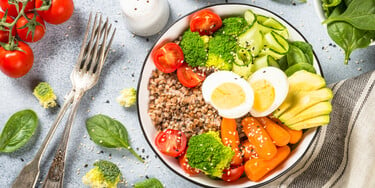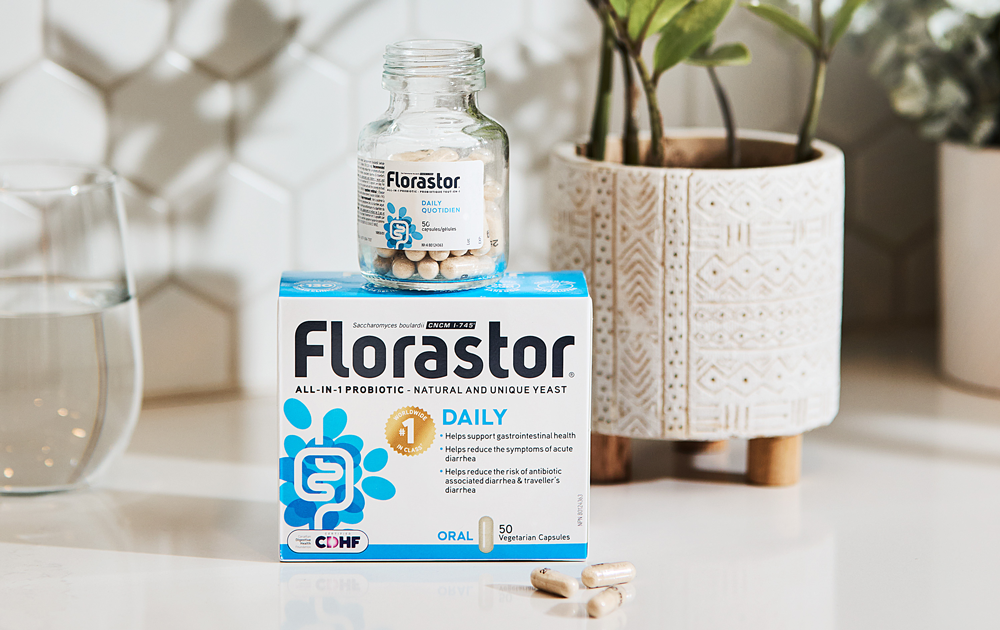Abdominal pain, bloating, gas, alternating diarrhea and constipation: these are the symptoms of irritable bowel syndrome. What should you eat and what should you avoid? Here are some recommendations.
Each case is unique
Irritable bowel syndrome (IBS) is a common functional disorder in which the intestine reacts excessively to stimuli, including food and stress. It is not an inflammatory disease.
Certain foods trigger or aggravate IBS symptoms. Which ones and in what quantities? There are as many answers as there are people who suffer from IBS.
Step one: make simple changes
Before switching to a very strict diet, it is often advisable to start with more accessible changes:
- Eat regular meals, don't skip them. Eat less but more often. Avoid large meals that can put extra stress on the digestive system.
- Chew well. Digestion begins in the mouth, thanks to enzymes and the mechanical action of the teeth. Avoid eating quickly, as this causes you to swallow more air, which increases the risk of gas and bloating.
- Drink enough water. Good hydration is essential for softening stools and keeping the digestive system functioning properly in cases of constipation. In cases of diarrhea, it is crucial for preventing dehydration.
- Cook food. Cooked foods are sometimes easier to digest than raw foods. Choose cooked fruits and vegetables over raw ones and see if this has a positive impact on your symptoms.
- Cut down on carbonated drinks, alcohol, caffeine, and high-fat foods, which can irritate the intestines or alter digestion.
These initial changes can already reduce symptoms in many people.
Second step if necessary: the low-FODMAP diet
If symptoms persist despite simple changes, the low FODMAP diet is the approach with the most evidence to relieve many people.
“FODMAP” stands for Fermentable Oligosaccharides, Disaccharides, Monosaccharides, and Polyols. These are a group of short-chain carbohydrates that are poorly absorbed in the small intestine. They can cause bloating, gas, and pain in sensitive individuals. They are found in various foods, including certain fruits, vegetables, grains, dairy products, and artificial sweeteners. There is a (non-exhaustive) list of these foods at the end of this article.
There are generally three phases to the low-FODMAP diet:
1. Strict elimination phase
Usually 2 to 6 weeks. All high FODMAPs are reduced as much as possible. This allows you to see if your symptoms improve.
2. Reintroduction phase:
Gradually reintroduce one type of FODMAP at a time (e.g., fructans, polyols, lactose, etc.) to identify which foods are problematic for the individual. This is often done over a few days for each category, while monitoring symptoms.
3. Maintenance phase (personalized)
Once trigger foods have been identified, the goal is to regain as much variety as possible while avoiding or limiting those that cause problems. The aim is to strike a balance between digestive comfort and enjoyment of food, while ensuring adequate nutritional intake.
Effectiveness of the Low-FODMAP diet
Several studies show that this diet significantly reduces symptoms. It allows you to identify, and therefore reduce or eliminate, foods that cause problems, without depriving yourself of those that are not involved. For example, a person can continue to eat foods that contain gluten if it can be confirmed that it is not the gluten in wheat or barley that is a trigger, but rather their fructans.
IMPORTANT: with a nutritionist
The low-FODMAP diet can be restrictive. Without monitoring, there is a risk of deficiencies (fiber, calcium, iron, certain vitamins), not to mention the monotony of the diet and the loss of enjoyment in eating.
The psychological aspect is important: restricting many foods can be stressful and even lead to problematic eating behaviors. It is therefore important for the person to feel supported.
Dietary diversity remains important for the gut microbiota. Studies show that the low-FODMAP diet alters the microbiota, and maintaining controlled diversity helps reduce potential negative effects.
The nutritionist will help plan the diet, suggest substitutions, ensure nutritional intake, and adapt to cultural preferences, known allergies/intolerances, and the type of IBS (constipation-predominant, diarrhea-predominant, mixed).
Other aspects to consider
Not all answers can be found on your plate. Stress, sleep, physical activity (or lack of exercise) can all influence IBS.
In addition, certain supplements may be helpful. Some approaches involve the use of enzymes that help digest foods rich in FODMAPs. Studies also suggest that certain probiotics may play a beneficial role in helping to relieve IBS symptoms and improve the balance of the microbiota.
The best approach, in summary
The keywords are:
Personalized approach. Each person reacts differently to foods and treatments.
Progression: start with less drastic dietary changes, then, if necessary, a well-structured low-FODMAP diet.
Professional support: work with a nutritionist who specializes in digestive disorders to identify foods and restrict as little as possible, to avoid deficiencies, and to adapt to tastes, culture, preferences, social constraints, and budget.
Comprehensive follow-up: include lifestyle (stress, sleep, physical activity), as IBS is an “gut-brain” phenomenon where all factors interact.
High FODMAP foods include:
Oligosaccharides (fructans and galacto-oligosaccharides)
- Wheat-based products such as bread and pasta
- Rye
- Barley
- Onions (including red onions, white onions, and the white part of shallots)
- Garlic
- Leeks (white bulb only)
- Asparagus
- Artichokes
- Beets
- Brussels sprouts
- Red, black, and pinto beans
Disaccharides (lactose)
- Milk
- Soft cheeses (such as ricotta and cottage cheese)
- Yogurt
- Ice cream
- Cream
- Certain processed foods containing milk powder or dry milk extracts
Monosaccharides (fructose)
- Apples
- Pears
- Mangoes
- Cherries
- Watermelon
- Cherry tomatoes
- High fructose corn syrup
- Honey
- Agave syrup
- Fruit juice
- Dried fruit (such as raisins, figs, and dates)
- Asparagus
- Snow peas
Polyols (such as sorbitol, mannitol, and others)
- Apples
- Pears
- Cherries
- Peaches
- Plums
- Sugar-free gum and candy
- Watermelon
- Cauliflower
- Snow peas
- Celery
- Other sugar alcohols, such as xylitol, maltitol, and isomalt, are used in some sugar-free and low-calorie foods.
References
1. Altomare A, Di Rosa C, Imperia E, Emerenziani S, Cicala M, Guarino MPL. Diarrhea Predominant-Irritable Bowel Syndrome (IBS-D): Effects of Different Nutritional Patterns on Intestinal Dysbiosis and Symptoms. Nutrients. 2021 Apr 29;13(5):1506. doi: 10.3390/nu13051506. PMID: 33946961; PMCID: PMC8146452.
2. Bertin L, Zanconato M, Crepaldi M, Marasco G, Cremon C, Barbara G, Barberio B, Zingone F, Savarino EV. The Role of the FODMAP Diet in IBS. Nutrients. 2024 Jan 26;16(3):370. doi: 10.3390/nu16030370. PMID: 38337655; PMCID: PMC10857121.
3. Radziszewska M, Smarkusz-Zarzecka J, Ostrowska L. Nutrition, Physical Activity and Supplementation in Irritable Bowel Syndrome. Nutrients. 2023 Aug 21;15(16):3662. doi: 10.3390/nu15163662. PMID: 37630852; PMCID: PMC10459186.
4. Staudacher HM, Whelan K. The low FODMAP diet: recent advances in understanding its mechanisms and efficacy in IBS. Gut. 2017 Aug;66(8):1517-1527. doi: 10.1136/gutjnl-2017-313750. Epub 2017 Jun 7. PMID: 28592442.
5. Farzaei, M. H., Bahramsoltani, R., Abdollahi, M., & Rahimi, R. (2016). The Role of Visceral Hypersensitivity in Irritable Bowel Syndrome: Pharmacological Targets and Novel Treatments. Journal of Neurogastroenterology and Motility, 22(4), 558-574.
6. Lomer M. C. E. (2024). The low FODMAP diet in clinical practice: where are we and what are the long-term considerations? The Proceedings of the Nutrition Society, 83(1), 17–27.


